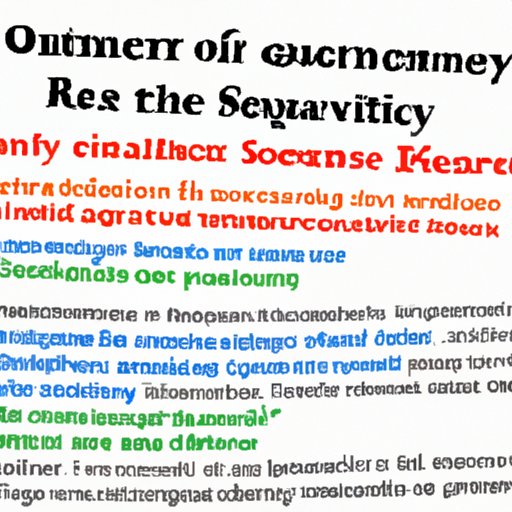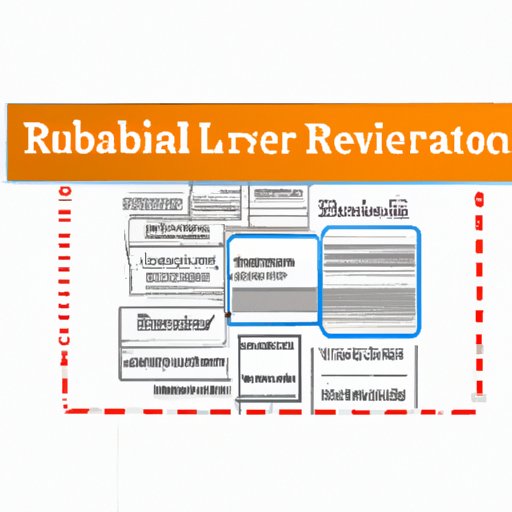Introduction
A literature review is a critical assessment and evaluation of existing research on a particular topic. It is used to summarize and synthesize the existing evidence on the chosen topic and provide an in-depth analysis of the available information. When done properly, a literature review can be an invaluable tool for identifying gaps in the current body of knowledge, developing new research questions, and informing future studies.
Organizing a literature review requires careful planning and attention to detail. This article outlines the key steps you need to take to ensure that your literature review is well organized and comprehensive.

Identify Relevant Sources of Information
The first step in organizing a literature review is to identify relevant sources of information. Start by using search engines and databases such as Google Scholar, PubMed, and Web of Science to locate academic articles on your topic. Make sure to use appropriate keywords and search terms to narrow down your search results and find the most relevant sources.
Once you have identified some relevant sources, it is important to determine whether they are reliable and trustworthy. Consider the author’s credentials, the journal the article was published in, and any reviews or citations the source has received. Conducting a thorough assessment of the source material will help you determine which sources are most valuable and relevant to your research.

Sort Through the Available Literature
Once you have identified relevant sources, it is time to sort through the available literature. Begin by reading through each source and identifying key themes and concepts that are related to your topic. As you read, make connections between different sources and look for any gaps in the existing body of knowledge.
For example, a study by Smith (2020) found that students who took online classes performed better than those who took in-person classes. This finding could be compared with another study by Jones (2021), which found that students who took blended classes (a combination of online and in-person classes) had the highest performance. By making connections between different sources, you can begin to build a cohesive argument and develop a structure for your literature review.
Develop a Structure for Organizing the Literature Review
Now that you have identified key themes and made connections between different sources, it is time to develop a structure for organizing the literature review. Begin by outlining your argument and creating subheadings for each section. This will help you keep track of the sources and make it easier to identify any gaps in the argument.
For example, if your literature review focuses on the effectiveness of online education, you might create subheadings such as “Benefits of Online Education”, “Challenges of Online Education”, and “Best Practices for Implementing Online Education”. This structure will help you stay focused and organized when writing up the literature review.

Assess Quality and Relevance of Sources
Once you have developed a structure for your literature review, it is important to assess the quality and relevance of each source. To do this, you should consider the purpose of each source and evaluate its credibility. Ask yourself: Is the source providing accurate, up-to-date information? Does it address the main question or issue you are exploring?
It is also important to consider the scope of each source. For example, if you are looking for information about the effectiveness of online education, a study focusing on the effectiveness of in-person education may not be relevant. By assessing the quality and relevance of each source, you can ensure that only the most valuable and useful sources are included in your literature review.
Create Annotated Bibliography
An annotated bibliography is a list of sources that includes a brief summary of each source. Keeping track of your sources with an annotated bibliography will help you stay organized and ensure that all of your sources are properly cited. For each source, include a brief summary of the main points, any relevant quotes, and a note about the source’s relevance to your research.
Creating an annotated bibliography will also help you save time when writing up the literature review. Instead of spending time trying to remember what each source said, you can quickly refer back to your annotated bibliography and easily incorporate relevant information into your review.
Write the Literature Review
Once you have identified relevant sources, sorted through the available literature, assessed the quality and relevance of each source, and created an annotated bibliography, it is time to write the literature review. Begin by explaining the connections between each source and your argument. Be sure to maintain consistency in your organization and use clear transitions between sections.
When writing the literature review, it is important to cite all of your sources correctly. Use the referencing style required by your institution and double-check that all sources are correctly cited. This will help ensure that you get full credit for the work you have done.
Conclusion
Organizing a literature review can be a daunting task, but it doesn’t have to be. By following the steps outlined in this article, you can ensure that your literature review is well structured and comprehensive. From identifying relevant sources to assessing quality and relevance to writing up the review, these steps will help you create a strong and effective literature review.
By taking the time to plan and organize your literature review, you can save time when writing up the review and make sure that your argument is well supported by the available evidence. Ultimately, taking the time to properly organize your literature review will help you produce a high-quality piece of research.
(Note: Is this article not meeting your expectations? Do you have knowledge or insights to share? Unlock new opportunities and expand your reach by joining our authors team. Click Registration to join us and share your expertise with our readers.)
